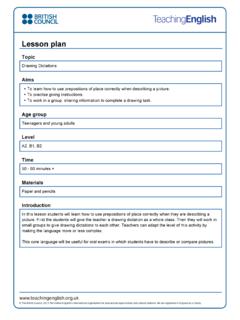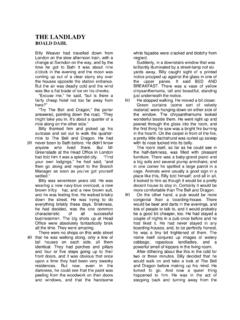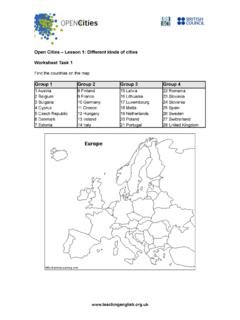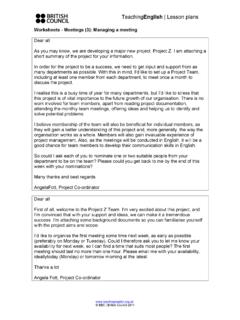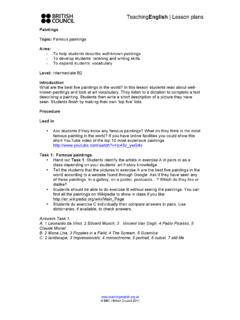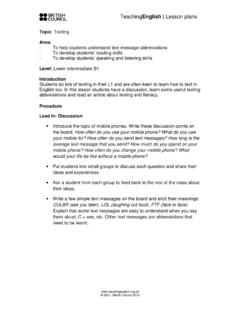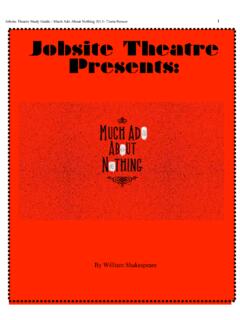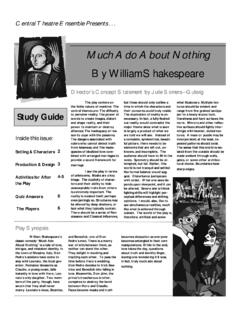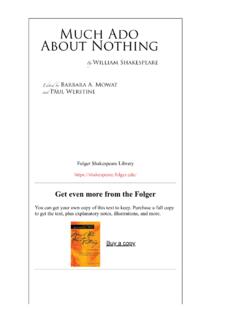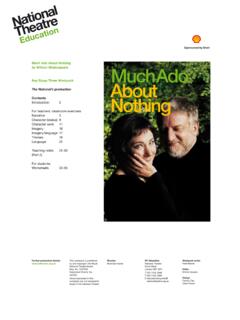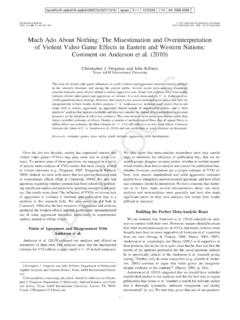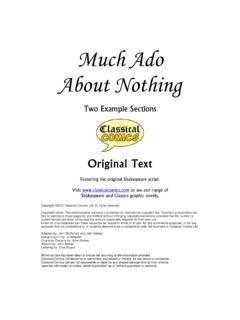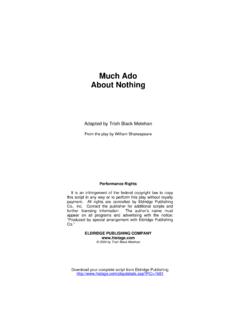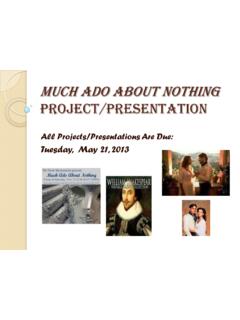Transcription of Lies in Shakespeare’s Much Ado About Nothing
1 The United Kingdom s international organisation for cultural relations and educational opportunities. A registered charity: 209131 (England and Wales) SC037733 (Scotland). Lies in Shakespeare s much Ado About Nothing Lesson plan Topic: Shakespeare and deception Level: B1 Time: 75 minutes Aims: To develop students knowledge of the plot and characters of much Ado About Nothing To develop students ability to read text for detail To give practice of discussing and justifying their opinions About lying Introduction This lesson begins by introducing the concept of telling lies and gets students to discuss this. Students are then introduced to the characters from the play by reading a text and answering questions About it. They then read the plot and identify as many lies and they can from the story. Learners then read a scene from the play (and possibly watch it) before answering questions About it.
2 Finally, students discuss a series of situations and justify whether they think the lies told in them are justifiable. Preparation and materials Make one copy of the student worksheets for each learner in the class. You may wish to go online and show a film version of the final scene, by entering the search terms much Ado final scene or much Ado act 5 scene 4 . Procedure Warmer Deception (10 minutes) The first part of this lesson is designed to get students to become familiar with the idea of everyday lies and what part they might play in their lives. Ask students to read the text in the box and then answer the questions in pairs. Allow students just a few minutes to come up with ideas before bringing the class together and eliciting their feedback to each question. You could also focus on the words in the word cloud on the right. Task 1 The characters in Shakespeare s much Ado About Nothing (15 minutes) Ask students if they have ever heard of the play much Ado About Nothing .
3 Write the name of the play on the board and ask students to suggest what it might mean basically a lot of trouble About Nothing . (a) Ask students to read the text About the characters and answer the questions below. When students have finished, ask them to share their answers with their partner before eliciting the answers as a whole class. Ask students individually to give the answers. Answers 1. Beatrice and Benedick 2. Claudio and Benedick 3. Beatrice, Benedick and Claudio 4. Claudio (he regrets accusing Hero of being unfaithful) 5. Hero 6. Claudio falls in love with Hero 7. Hero Beatrice and Benedick 8. Beatrice defends her cousin Hero when she is accused of being unfaithful. Now get students to do question (b) in pairs. Ask them to circle all the words that are somehow linked to either truth or lies in the text. Ask students to share their ideas with each other before you elicit the words that are linked with lies or truth.
4 Some of these words take different word forms and you might like to explore some of these with students. Suggested answers Loyal, swear, fool (v), gullible, believe, unfaithful, deceive, deny, pretend, deception Task 2 The plot of much Ado About Nothing (15 minutes) Ask students to read the text in pairs and identify all the lies they can. Give them About ten minutes to read through the plot and identify the lies before you go through the suggested answers below as a class. Answers Beatrice s cousins lie to her that Benedick loves her. - Don Pedro lies to Benedick that Beatrice loves her. - Don John lies to Claudio that Hero has been unfaithful. - Hero s family pretend (lie) that she is dead. - Hero s family lies to Claudio that he is going to marry another girl. Task 3 Motivation (10 minutes) Students have already seen the word motivation the warmer section, but make sure they understand what this word means.
5 Explain that students are going to use the text to match each character with their motivation for the lies. Again, have students share their answers with each other to maximize their communication time before you go through the answers as a whole group. Answers: Task 4 Reading a scene (15 minutes) Here students get to read a scene from much Ado About Nothing and answer some questions on it. Depending on how outgoing your class is, you could get students to read and act this out together. Shakespeare s words were meant to be spoken out loud and are often much easier to understand if they are heard. You can also see a great version of this scene by going to and searching for much Ado About Nothing Beatrice and Benedick final scene . (a) Ask students if they can guess what the characters are holding, and how this might be important in the film, but do not spend too long on this.
6 (b) Get them either to read or listen to the text, or to watch the extract, and to find out what the characters are holding, and why this is important. (c) Ask students to decide if the sentences are true or false before eliciting the answers from the class. Answers: (a) & (b) They are holding love poems they have written About each other. (c) 1. true 2. false they told her that he loved her 3. false Benedick wrote it 4. true 5. true 6. true Task 5 Discussion (10 minutes) Before you start this discussion, pre-teach the words acceptable and unacceptable . Discuss the first question as a whole group to make sure students understand what these words mean. In pairs or small groups (perhaps different from in the previous tasks), ask student to discuss the situations together About lies and deceit in everyday life. Encourage them to justify why they think the lies may be acceptable or unacceptable After students have finished talking, ask them to feedback some of their ideas as a group.
7 Develop some of the reasons why they believe it s okay to lie in some situations and not in others, indeed, sometimes lies are helpful and even polite in everyday life.
